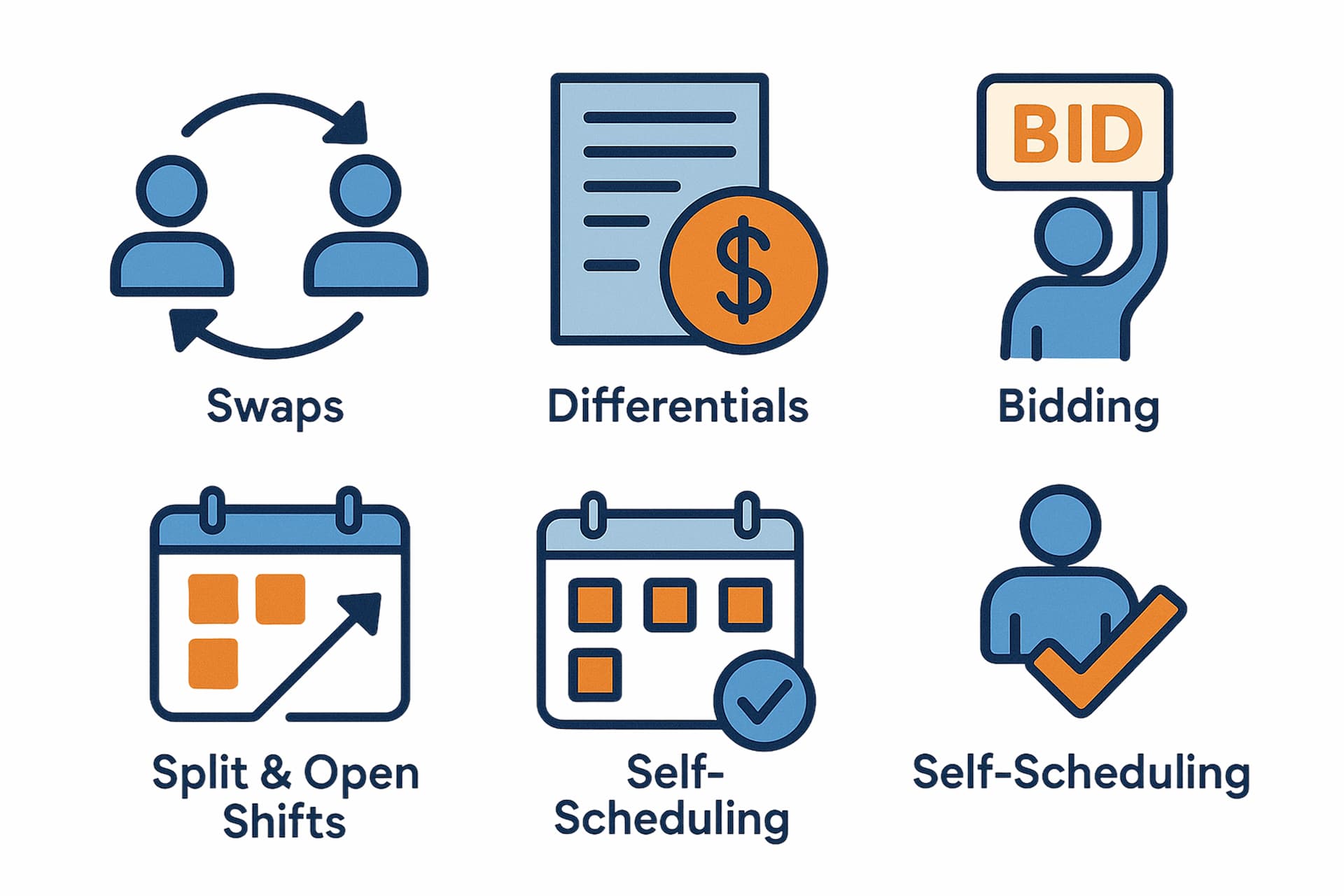Running a healthcare organization means balancing patient care, compliance, and labor costs - all while keeping your staff engaged and schedules accurate. Workforce management software brings all those moving parts together. It’s not just about shifts; it’s about visibility across staffing, time tracking, attendance, and employee well-being.
Whether you’re managing a hospital, outpatient clinic, or long-term care facility, the goal is the same - to ensure the right qualified people are in the right place at the right time. Below are trusted tools that help healthcare leaders manage labor efficiently, stay compliant, and support their teams without adding administrative burden.
Must-have features of healthcare workforce management software
Effective workforce management goes beyond scheduling. It integrates time tracking, attendance, and compliance into one clear view - helping administrators plan smarter and respond faster.
Centralized visibility. Workforce management platforms unify scheduling, time tracking, and communication in one place, giving leaders real-time visibility across teams and locations.
Automated scheduling. The system can automatically suggest or build schedules based on skills, availability, and labor rules — saving hours of manual work each week.
Time and attendance tracking. Accurate tracking of hours, breaks, and overtime keeps payroll fair and compliant, while reducing administrative overhead.
Compliance & credential management. The software enforces labor laws, rest requirements, and certifications to prevent staffing violations or missed qualifications.
Analytics & reporting. Workforce analytics reveal patterns in overtime, utilization, and coverage, helping managers make data-driven staffing decisions.
Ensuring coverage. Healthcare never stops. Good workforce planning ensures the right number of qualified staff are present for every shift and every department.
Managing complexities. Hospitals and clinics operate 24/7 with rotating roles, on-call shifts, and unique regulations. Smart software keeps this complexity organized.
Balancing staff needs. Workforce management is not just about staffing levels — it’s about aligning patient demand with employee well-being, reducing fatigue and turnover.
Handling last-minute changes. Emergencies, absences, and census changes happen. Modern tools help you react instantly while maintaining proper coverage.
Mobile access. Staff moving between departments or patient homes can check schedules, clock in, and request changes from any device.
Shift swapping. Let employees trade shifts with manager approval — keeping flexibility while maintaining accountability.
Built-in communication. Messaging and announcements happen within the same platform, eliminating the need for separate chat or text apps.
Real-time notifications. Everyone stays informed with instant alerts about open shifts, approvals, and last-minute updates.
Improved patient care. Consistent, transparent scheduling helps teams stay rested and focused — directly improving quality and safety of care.
Higher efficiency and satisfaction. Fewer manual edits, fewer conflicts, and smoother collaboration mean happier staff and more stable operations.
For specific roles, check pages for nurse managers, clinic managers, medical offices, home-care, and pharmacy.
How healthcare workforce management software works
Workforce management systems simplify how healthcare leaders plan, track, and manage their staff. Instead of juggling spreadsheets, messages, and manual edits, managers can use one platform that centralizes scheduling, timekeeping, and compliance tasks.
Modern tools use visual planners, mobile apps, and automation to create accurate schedules in minutes. Staff receive instant notifications about shifts, can check in via GPS or kiosks, and log time directly into timesheets. Complex rotation patterns like Pitman, Panama, or 2-2-3 are supported automatically.
These platforms integrate with HR and payroll systems, reducing administrative burden. Compliance alerts ensure schedules align with labor laws and rest requirements. Managers gain real-time visibility into coverage, overtime, and labor costs - making workforce decisions faster and more precise.
In short, healthcare workforce management software turns fragmented processes into one organized, data-driven workflow that benefits staff, managers, and patients alike.
Best healthcare workforce management software
Below are widely used options across hospitals, clinics, and care organizations. We summarize what each does best, typical pricing, and key user feedback.
Shifts by Everhour
Best for unified scheduling + time tracking with clean mobile experience
- Free plan available
- From $4/user/month (billed annually)
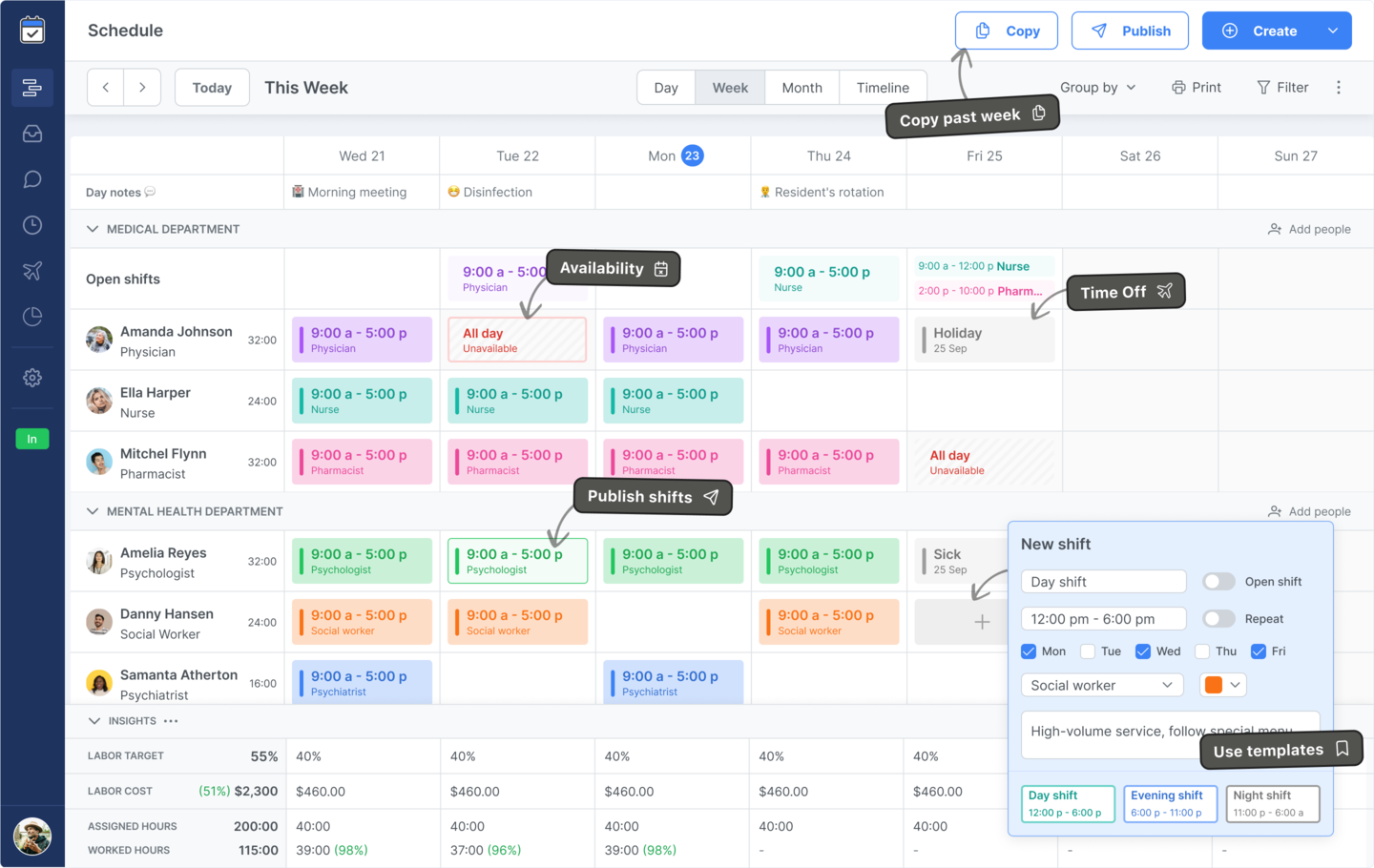
Shifts by Everhour brings schedules, time clocks, PTO, and team messages into one place-ideal for clinics, private practices, home-health, and departments that need clarity over complexity. Explore employee shift scheduling, scheduling + time clock, and engagement tools.
Key Features
- Combined scheduling + GPS time clock
- Mobile self-service: swaps, bids, PTO, availability
- Open shifts, templates and instant publish
- Team messaging & announcements in one app
- Clear visibility into overtime and labor hours
- Simple rollouts for small to midsize care teams
Pros / Cons
- One app for schedules, time, and communication
- Fast onboarding, intuitive for non-technical staff
- Great for multi-site outpatient and home-health
- Fewer deep enterprise integrations
- Advanced analytics still evolving
Connecteam
Best for all-in-one operations with HIPAA-friendly workflows
- Free plan for small teams (feature-limited)
- Tiered pricing by feature set
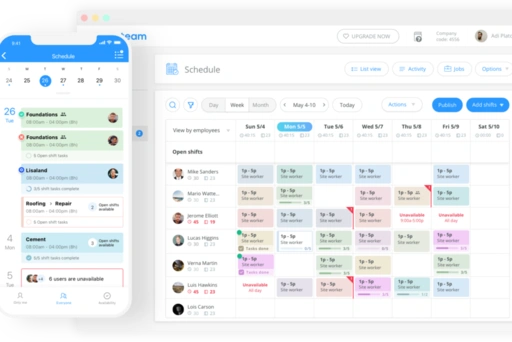
Often praised for a HIPAA-compliant, user-friendly interface. Combines scheduling with tasking, forms, and training modules-useful for multi-site clinics and ancillary departments.
Key Features
- Drag-and-drop scheduling & shift templates
- Mobile app with self-service requests
- Forms, checklists, training, and chats
- Role-based permissions and auditing
- Kiosk and GPS time clocks
- Basic reporting & acknowledgments
Pros / Cons
- Broad “all-in-one” feature set beyond scheduling
- Simple mobile UX helps adoption
- Depth of scheduling analytics varies by plan
- Can feel heavy if you only need scheduling
Deputy
Best for labor cost control with robust scheduling + timekeeping
- Free trial available
- From ~$4.50–$6.50/user/month (annual)
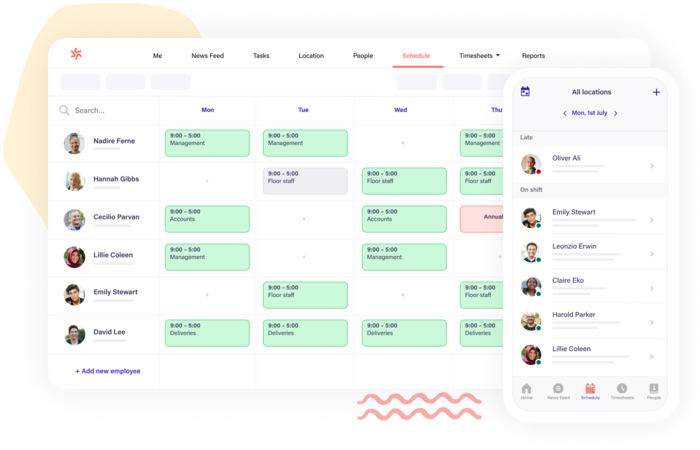
Deputy ties schedules tightly to attendance and overtime rules, helping prevent overages while keeping teams informed. Popular in high-volume environments (urgent care, outpatient, ancillary services). Related reads: hospital scheduling software.
Key Features
- Intuitive schedule builder & mobile clock-in/out
- Real-time compliance (overtime, breaks)
- Multiple location & role support
- Shift swap, open shifts, notifications
- Timesheets & payroll integrations
- Basic demand forecasting
Pros / Cons
- Good balance of ease-of-use and control
- Strong timekeeping + scheduling linkage
- Some advanced reports behind higher tiers
- Occasional mobile performance complaints
Sling
Best for budget-friendly scheduling with cost visibility
- Free plan (limited)
- From ~$1.70/user/month (annual) for premium tiers
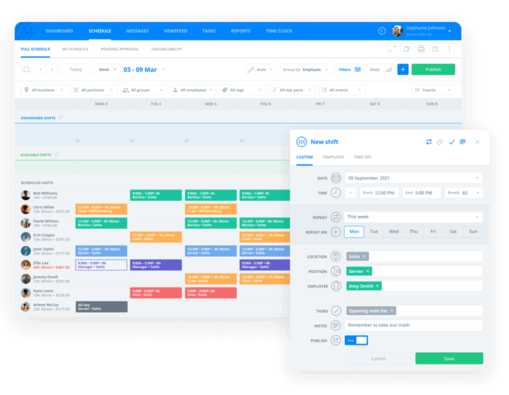
Sling offers simple scheduling plus labor-cost views-handy for outpatient clinics, imaging centers, and ancillary departments managing tight margins. See also our free scheduling software comparison.
Key Features
- Shift scheduling with cost estimates
- Attendance & clock-in/out options
- Team messaging & alerts
- Open shifts & swap requests
- PTO & availability tracking
- Basic reporting
Pros / Cons
- Very affordable for small departments
- Simple, quick to roll out
- Mobile interface less polished for some users
- Fewer advanced compliance features
QGenda
Best for enterprise-grade provider scheduling & workforce optimization
- Demo-based pricing
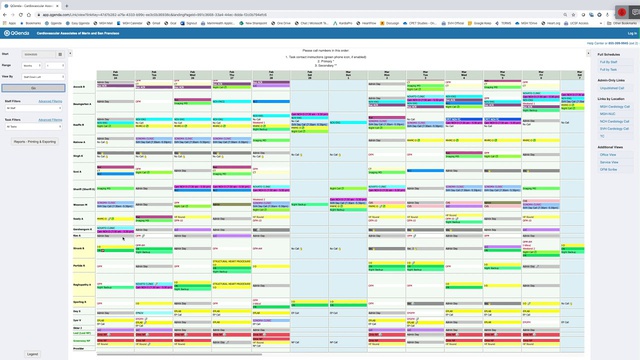
A widely adopted hospital platform emphasizing provider scheduling, on-call, and optimization for patient access. Users highlight customization and helpful support; setup can be complex and time-consuming for large orgs.
Key Features
- Physician & APP scheduling with complex rules
- On-call rosters, rotations, and request workflows
- Analytics on utilization and access
- Role-based portals & mobile access
- Integrations with hospital systems (varies)
- Enterprise controls & auditing
Pros / Cons
- Powerful for complex provider groups
- Flexible configuration options
- Lengthy setup, steeper learning curve
- Mobile UX feedback varies by team
OnShift
Best for long-term care & senior living (scheduling + labor control)
- Demo-based pricing
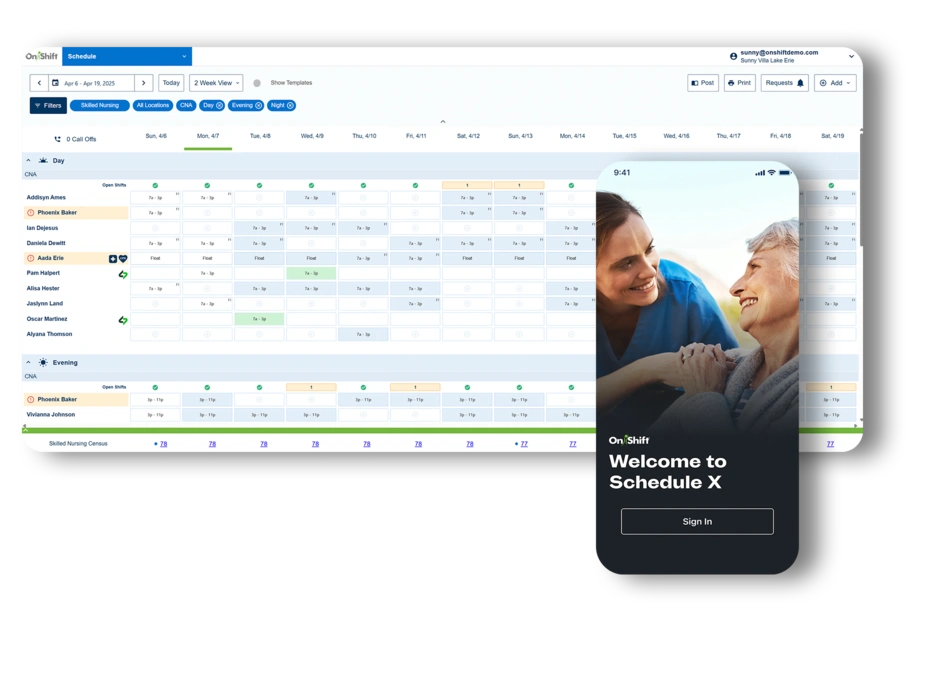
Suited to LTC and senior care. Users like ease of navigation and time-saving automation; some mention notification quirks and data-sync limitations in specific setups. See also our caregiver scheduling resources.
Key Features
- Scheduling with overtime & call-out controls
- Mobile access & messaging
- Timesheets & attendance
- Reports for staffing & cost
- Open shifts and swap workflows
- Multi-facility management
Pros / Cons
- Designed for LTC staffing realities
- Clear reports and hour tracking
- Notifications can be inconsistent for some users
- Setup/customization complexity at scale
MakeShift
Best for ease-of-use with strong shift trading and future planning
- Free trial available
- From ~$5.75/employee/month
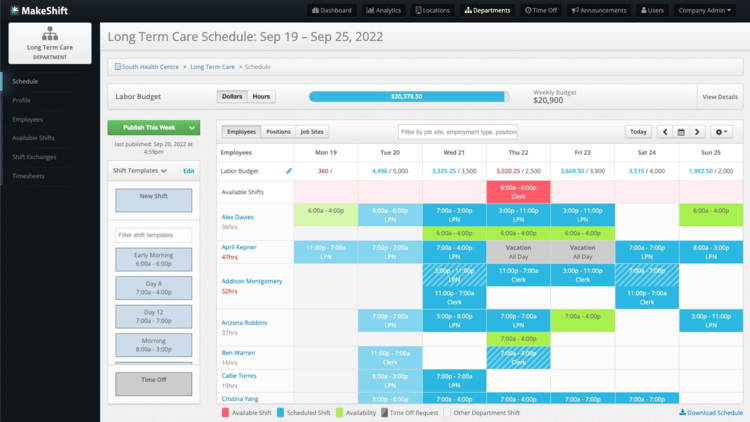
Users praise quick scheduling and time savings; wish lists include more customizable reports and richer communication tools. Good for clinics that value simple, clean UX.
Key Features
- Fast schedule building & future planning
- Shift trading & availability
- Mobile app for staff self-service
- Basic reporting & notifications
- Multi-location support
- PTO & approvals
Pros / Cons
- Very easy to learn for staff
- Great for shift trading
- Limited custom reporting for some needs
- Smaller ecosystem vs. big vendors
OnPage
Best for on-call alerting & incident response in clinical settings
- Free trial available
- From $13.99/employee/month
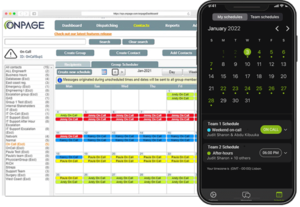
Complements scheduling with reliable critical alerting and on-call management. Users like dependable notifications; some report sound/transcription quirks and alert fatigue if misconfigured.
Key Features
- On-call scheduling & escalations
- Secure messaging & alerting
- Mobile apps with audit trails
- Integrations for incident workflows
- Message delivery confirmations
- Reporting on response SLAs
Pros / Cons
- Very reliable critical notifications
- Strong for on-call rotations
- Sound/transcription limitations noted
- Needs careful tuning to avoid alert fatigue
EasyShifts
Best for small clinics wanting quick, simple scheduling
- Free trial available
- From $4.99/employee/month
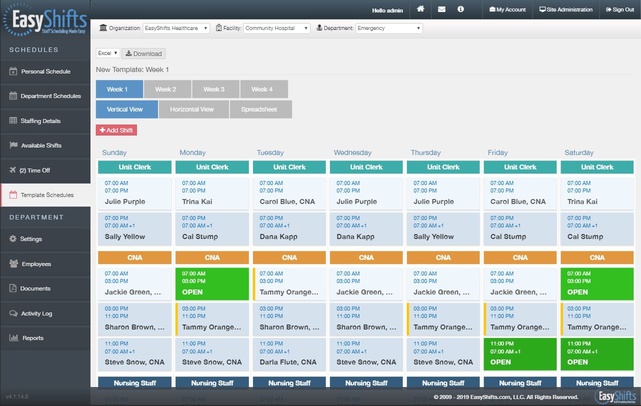
Praised for simplicity and helpful support; feature limits and occasional notification issues are noted by some users. A lean choice for small teams and single-site clinics.
Key Features
- Quick schedule edits & mobile access
- Open shifts & availability
- PTO requests & approvals
- Basic reporting & alerts
- Real-time shift updates
- Light learning curve
Pros / Cons
- Very fast to get started
- Support often rated highly
- Limited PTO and customization for some needs
- Occasional glitches entering availability
Featured Tools
How to choose the right healthcare workforce management software
Choosing workforce management software starts with mapping your organization’s structure. Hospitals need multi-department coordination and compliance checks; clinics often need integrated time tracking and reporting; long-term care facilities benefit from flexible coverage tools and mobile-first access.
Evaluate how each system handles your core workflows - scheduling, attendance, payroll, and credential management. The best platforms connect these elements seamlessly and provide analytics for labor cost forecasting.
Ensure the software supports mobile access for on-the-go staff, integrates with HR or payroll systems, and includes reporting to support compliance with healthcare regulations.
Benefits & ROI of healthcare workforce management
Modern workforce management systems reduce chaos, automate compliance, and improve both staff and patient outcomes. When healthcare professionals know their hours, get fair workloads, and can rest properly, performance and morale rise - leading to fewer absences and higher retention.
Automated labor tracking, credential-based scheduling, and analytics help leaders match staffing to patient demand. Hospitals using these systems report lower overtime costs and fewer scheduling errors, while improving care continuity.
Workforce management is also a financial win. According to Nucleus Research, organizations see an average return of $7.88 for every dollar invested - thanks to fewer manual processes, better coverage, and smarter staffing allocation.
“Workforce management systems can deliver an average return of $7.88 for every dollar invested, thanks to fewer errors, better staffing allocation and higher productivity”
Adoption tips for smooth rollout
Rolling out new workforce management software works best when it feels like an upgrade, not a disruption. Start small, communicate clearly, and build confidence step by step.
Begin with a pilot in one department. Add the first portion of shifts, let the team test real workflows, and collect feedback before expanding. Early success stories help others see the value and reduce resistance.
Keep training simple and practical. Short videos or live demos are far more effective than manuals. Encourage users to try key features themselves - creating shifts, swapping, and requesting time off - until it becomes second nature.
And most importantly, make self-service the core experience. When staff can easily claim open shifts, mark availability, and see updates instantly, adoption grows naturally across the organization.
The bottom line
Healthcare workforce management isn’t only about tracking time - it’s about building a resilient, efficient, and motivated team. Choose a tool that connects scheduling, time tracking, and analytics, so you can focus on delivering quality care, not managing spreadsheets.


